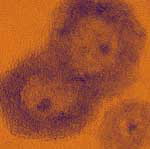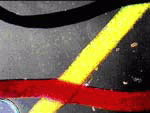FOR IMMEDIATE RELEASE
ACS News Service Weekly PressPac: January 24, 2007
ACS News Service Weekly PressPac: Jan. 24, 2007
News Items in This Edition
Journalists’ Resources
Mark Your Calendars
Note to Journalists and Other Viewers
The American Chemical Society (ACS) News Service Weekly PressPac (PressPac) offers information on reports selected from 35 major peer-reviewed journals and Chemical & Engineering News.
This information is intended for your personal use in news gathering and reporting and should not be distributed to others. Anyone using advance ACS News Service Weekly PressPac information for stocks or securities dealing may be guilty of insider trading under the federal Securities Exchange Act of 1934.
Please cite the individual journal, or the American Chemical Society, as the source of this information.
News Items in this Edition
Related Links
Scientists in Hong Kong are reporting synthesis and early laboratory tests of a new nanostructure that they believe may lead to the design of an anticancer nanomedicine.
In a study scheduled for publication in the Feb. 21 issue of the weekly Journal of the American Chemical Society, Bing Xu and colleagues describe the structure as an eggshell nanocrystal.
Like a chicken’s egg, the structure has an outer shell that encloses a “yolk” that can be released from the shell. In their experiments, the researchers used a yolk consisting of iron and platinum, the metal responsible for the
Journal Information
Journal: Journal of the American Chemical Society
Journal Article: “FePt@CoS2 Yolk-Shell Nanocrystals as a Potent Agent To Kill HeLa Cells”
activity of the widely used chemotherapeutic drug, cisplatin. Cultures of human cancer cells took up the nanostructures and the nanostructures released their yolks, which proved to have “exceptionally high toxicity” for the cancer cells.
“This type of yolk-shell nanostructures may lead to novel nanomedicine for treating cancers,” the researchers state, describing nanostructures that may be coated with antibodies that specifically target cancer cells and thus reduce body-wide side effects that occur with traditional chemotherapeutic drugs.

Nanostructures
With sale of counterfeit drugs causing major problems around the world, scientists in the United Kingdom are reporting development of a new way of identifying fake pills and capsules without opening the product package. In a report scheduled for the March 1 issue of ACS’ Analytical Chemistry, a semi-monthly journal, Pavel Matousek and Charlotte Eliasson describe the growing need for non-invasive verification of the authenticity of pharmaceutical products.
The report notes, for instance, that large quantities of counterfeit drugs have been withdrawn from the market in recent years in the United States and the U. K., with fake anti-malaria drugs causing a major crisis in eastern Asia. Verification can be difficult, the researchers explain, because medications must be analyzed without opening the product package. Once a drug package is open, the product usually cannot be marketed.
The investigators describe development of a new form of Raman spectroscopy, a mainstay tool for identifying molecules, which can probe deep layers of material that are well beyond the reach of conventional Raman spectroscopy. The method, spatially offset Raman spectroscopy, can analyze through paper packaging, plastic containers, capsule shells, and tablet coatings to verify the ingredients in a pharmaceutical product, the researchers state.
Journal Information
Journal: Analytical Chemistry
Journal Article: “Noninvasive Authentication of Pharmaceutical Products through Packaging Using Spatially Offset Raman Spectroscopy”
Smooth as silk. Warm as wool; ______as wheat gluten. Marketing specialists may be challenged to fill in that blank in the future, now that scientists in Nebraska report the first successful production of high-quality fibers from wheat gluten, that grain’s major protein. In an article scheduled for the Feb. 12, issue of ACS’ Biomacromolecules, a monthly journal, they describe the new fibers as having mechanical properties similar to wool. Some of the properties of wheat gluten fibers also are superior to soy protein and casein materials intended for biomedical applications, the report states.
Wheat gluten fibers would have a major cost advantage over both wool and silk, the two existing commercial natural protein fibers, according to the researchers. While wool sells for about $5-$8 per pound, and silk for $10
Journal Information
Journal: Biomacromolecules
Journal Article: “Novel Protein Fibers from Wheat Gluten”
-$14 per pound, wheat gluten fetches less than 50 cents per pound and huge quantities are available worldwide.
The report describes recent efforts to produce commercial quantities of fiber from milk, corn, peanut and other proteins. “Unfortunately, none of these attempts have been commercially successful to produce 100 percent protein fibers mainly due to the high cost and poor quality of the fibers,” the report adds. It includes a description of the properties of wheat gluten fibers and images of fiber strands.

Fibers
Scientists studying the health benefits of flavonoids — those disease-preventing compounds in fruits, vegetables, wine, dark chocolate and other foods — finally have comprehensive data on flavonoid levels in foods consumers buy in the United States. The U. S. Department of Agriculture’s James M. Harnly and colleagues are unveiling new flavonoid data collected from the first systematic sampling of foods designed specifically to characterize flavonoids. The report appeared in the Jan. 10 issue of the ACS’ Journal of Agricultural and Food Chemistry, a bi-weekly publication.
The report notes that interest in the flavonoid content of foods dates to the early 1980s. Since then, two databases had been compiled on levels of these compounds in common foods; the first based on a critical evaluation of flavonoid data in the literature and the second based on the analysis of proanthocyanidins found in selected foods. The reported data have been combined with the literature database.
For the latest report, researchers determined levels of 20 flavonoids in more than 60 fresh fruits, vegetables and nuts collected at two different times of the year from commercial markets in four regions of the United States. Researchers analyzed an average of five samples for each food. Complete results are included in the article. They found flavonoid levels that compared well with the literature database, but the catechins were generally lower in fruits and nuts than the figures reported in the proanthocyanidin database. The new study found a high variability in the flavonoid content of food samples.
Journal Information
Journal: Journal of Agricultural and Food Chemistry
Journal Article: “Flavonoid Content of U. S. Fruits, Vegetables, and Nuts”
“Green” laundry detergents have taken the leading role in a new effort by retailers and industry to market mainstream, environmentally friendly consumer products, according to an article scheduled for the Jan. 29 issue of ACS’ weekly newsmagazine, Chemical & Engineering News.
In the article, assistant managing editor Michael McCoy describes how the cleaning products industry has embraced sustainability, with a variety of innovations. One, for instance, is an energy-efficient laundry detergent that cleans without hot water. Others are laundry detergents that cause less water pollution after they go down the drain.
Wal-Mart Stores, Inc. has been a major catalyst in the green detergent revolution, the article states. Using its purchasing power as the world’s biggest retailer, Wal-Mart launched an environmental initiative last October to encourage its suppliers to manufacture more environmentally friendly laundry detergents. Laws and regulations in the United States and the European Union are giving industry additional regulatory incentive to go green with mainstream consumer products, the article adds.
A companion story describes developments in getting detergents to deliver perfume to the laundry — including approaches that adapt leading edge drug delivery technologies for transferring fragrances and other cleaning ingredients to laundry targets that include shirts, pants, sheets and underwear.
Journalists’ Resources
- ACS Chemical Biology
Highlights from the American Chemical Society journal, ACS Chemical Biology, are now available on EurekAlert!, the online science news service for reporters. ACS Chemical Biology is a monthly journal exploring cellular function from both chemical and biological perspectives. In addition to research papers and reviews, the journal also publishes “Spotlight” — current research in chemical biology from other journals; “Profile” — experts in the field; and “Points of View” — comments from leading scientists. The journal’s Web site is updated weekly with new content, and features a WIKI and an “Ask the Expert” section.
ACS National Meeting — Chicago, March 25-29
The American Chemical Society’s 233rd national meeting promises to be one of 2007’s biggest and most productive science conferences, and a bonanza of spot news, feature topics and background for reporters covering science, medicine, energy, environment, food, business or the environment. We expect more than 9,000 scientific papers on topics spanning science’s horizons from astronomy to zoology. Visit the National Meeting page for preliminary program information, media registration and housing.
News media are invited to a special event at the Art Institute of Chicago, scheduled during the ACS national meeting. The Art Institute, Northwestern University and Argonne National Laboratory are partners in a noted art conservation science program. Reporters will get briefings from program scientists and a behind-the-scenes tour of science and conservation labs, followed by a reception in the beautiful environs of the Institute. The event begins at 4 p.m. on March 26. Space is strictly limited, so register early by contacting Michael Woods at m_woods@acs.org or 202-872-6293.
Chemistry has an increasingly important role in research on cancer diagnosis, prevention and treatment.
To spotlight that role, the American Chemical Society (ACS) and the American Association for Cancer Research (AACR) will cosponsor a special conference entitled Chemistry in Cancer Research: A Vital Partnership on Feb. 4-7 in San Diego, Calif.
The program will feature presentations by prominent scientists on drug discovery, proteomics, the chemical biology of carcinogenesis, biomarkers and analytical chemistry, modeling and bioinformatics, and structural biology.
For information on press registration for the meeting, visit the AACR Special Conferences page or call the AACR Communications Department, (215) 440-9300, ext. 101.
The American Chemical Society — the world’s largest scientific society — is a nonprofit organization chartered by the U.S. Congress and a global leader in providing access to chemistry-related research through its multiple databases, peer-reviewed journals and scientific conferences. Its main offices are in Washington, D.C., and Columbus, Ohio.
Journal Information
Journal: Chemical & Engineering News
Journal Article: “Going Green: Pushed by Wal-Mart, legislators, and the public, the cleaning products industry embraces sustainability”

